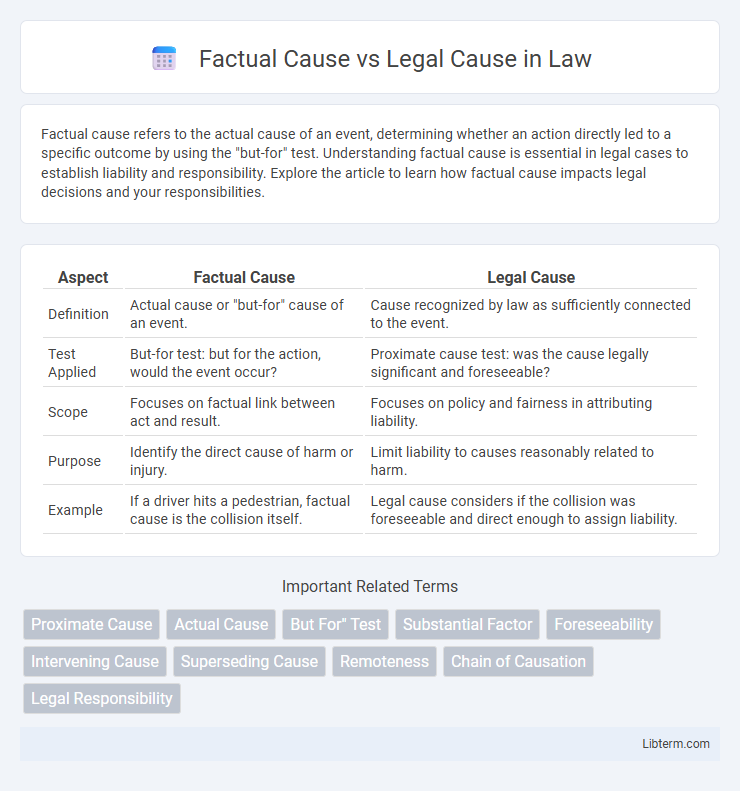Factual cause refers to the actual cause of an event, determining whether an action directly led to a specific outcome by using the "but-for" test. Understanding factual cause is essential in legal cases to establish liability and responsibility. Explore the article to learn how factual cause impacts legal decisions and your responsibilities.
Table of Comparison
| Aspect | Factual Cause | Legal Cause |
|---|---|---|
| Definition | Actual cause or "but-for" cause of an event. | Cause recognized by law as sufficiently connected to the event. |
| Test Applied | But-for test: but for the action, would the event occur? | Proximate cause test: was the cause legally significant and foreseeable? |
| Scope | Focuses on factual link between act and result. | Focuses on policy and fairness in attributing liability. |
| Purpose | Identify the direct cause of harm or injury. | Limit liability to causes reasonably related to harm. |
| Example | If a driver hits a pedestrian, factual cause is the collision itself. | Legal cause considers if the collision was foreseeable and direct enough to assign liability. |
Understanding Factual Cause: The Basics
Factual cause, often referred to as "cause-in-fact," establishes a direct link between an action and an result through the "but-for" test, meaning the harm would not have occurred but for the defendant's conduct. It serves as the foundational element in causation analysis, determining whether a specific act was a necessary condition for the injury. Understanding factual cause is crucial for differentiating it from legal cause, which involves policy considerations beyond mere causation.
Defining Legal Cause: An Overview
Legal cause, also known as proximate cause, refers to the element in tort law that establishes a direct link between a defendant's conduct and the resulting harm, limiting liability to consequences that are reasonably foreseeable. Unlike factual cause, which is determined by the "but-for" test assessing whether the harm would have occurred absent the defendant's actions, legal cause considers policy factors and the scope of liability. Courts rely on legal cause to ensure fairness by preventing unlimited responsibility for unforeseeable or remotely connected damages.
Factual Cause (Cause-in-Fact): Key Principles
Factual cause, also known as cause-in-fact, is established when the harm would not have occurred "but for" the defendant's conduct, emphasizing direct causation in fact. Key principles include the "but-for" test and the "substantial factor" test, which determine whether the defendant's actions were a necessary condition for the injury. Establishing factual cause is critical for liability as it provides the factual link between the defendant's conduct and the harm suffered.
Legal Cause (Proximate Cause): Core Concepts
Legal cause, or proximate cause, defines the scope of a defendant's liability by linking conduct to harm through foreseeability and directness. It limits responsibility to consequences reasonably predictable from the defendant's actions, preventing endless liability for remote results. Courts analyze whether the harm was a natural and probable outcome of the conduct, establishing the legal boundary for causation in tort law.
The "But-For" Test in Factual Causation
The "But-For" test in factual causation determines whether the harm would have occurred but for the defendant's actions, establishing a direct cause-and-effect relationship. This test is crucial in differentiating factual cause, which relies on actual causation, from legal cause that considers foreseeability and proximate cause. Courts apply the "But-For" test to ascertain if the defendant's conduct was a necessary condition for the damage, setting the foundation for liability.
Foreseeability in Legal Causation
Foreseeability is a key element in distinguishing legal cause from factual cause, as it limits liability to consequences that a reasonable person could predict. While factual cause considers whether the defendant's actions were a necessary condition for the harm, legal cause requires that the harm be a foreseeable result of those actions. Courts often apply the foreseeability test to ensure fairness by preventing limitless liability for unforeseeable consequences.
Common Confusions: Factual vs Legal Cause
Common confusions surrounding factual cause and legal cause often stem from their differing roles in establishing liability. Factual cause, also known as cause-in-fact, refers to the direct link between an action and the resulting harm, typically determined by the "but-for" test. Legal cause, or proximate cause, addresses whether the harm was a foreseeable consequence of the action, limiting liability to outcomes reasonably connected to the conduct.
Case Law Examples: Distinguishing the Two Causes
Factual cause, established through the "but-for" test, determines whether the harm would not have occurred without the defendant's actions, as seen in the landmark case of *Palsgraf v. Long Island Railroad Co.* Legal cause, or proximate cause, limits liability to consequences closely connected to the defendant's conduct, illustrated by *Wagon Mound (No. 1)* where unforeseeable damages were ruled too remote. These cases underscore that factual cause addresses actual event sequence, while legal cause involves policy judgments about fairness and foreseeability in imposing liability.
The Role of Causation in Tort Law
Factual cause, often determined by the "but-for" test, establishes whether harm would have occurred without the defendant's conduct, serving as the foundational link in tort liability. Legal cause, or proximate cause, limits liability to consequences closely connected to the defendant's actions, emphasizing foreseeability and policy considerations. Together, these causation elements ensure that tort law assigns responsibility fairly by connecting wrongful acts to actual and legally significant damages.
Practical Implications for Legal Practitioners
Factual cause, often referred to as "cause-in-fact," establishes a direct link between an action and an outcome, playing a critical role in determining liability by proving that the harm would not have occurred "but for" the defendant's conduct. Legal cause, or proximate cause, limits liability to consequences reasonably foreseeable from the defendant's actions, shaping strategic considerations for attorneys in crafting arguments on the scope of responsibility. Legal practitioners must meticulously analyze both causation elements to construct robust liability claims or defenses, balancing evidentiary proof with judicial standards to optimize case outcomes.
Factual Cause Infographic

 libterm.com
libterm.com